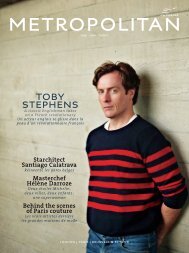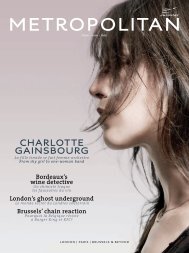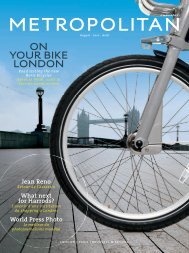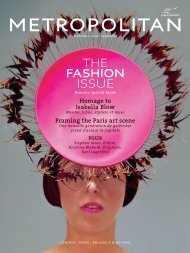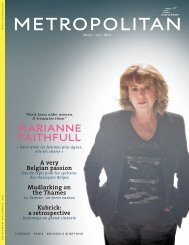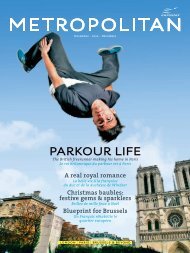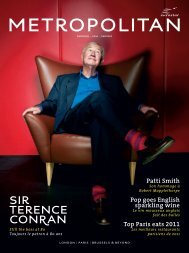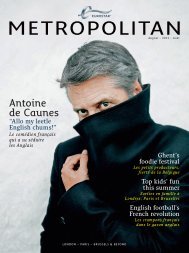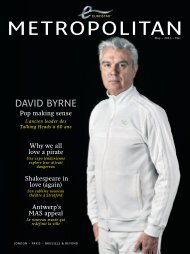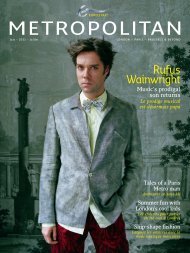april-2011
april-2011
april-2011
Create successful ePaper yourself
Turn your PDF publications into a flip-book with our unique Google optimized e-Paper software.
eauty<br />
The cult of<br />
Opposite<br />
page:<br />
Pavonia,<br />
Frederic<br />
Leighton,<br />
1858<br />
114 metropolitan<br />
From Gabriel Dante Rossetti to William Morris, a new London exhibition unites the<br />
work of a group of bohemian artists and thinkers whose devotion to beauty and purity<br />
scandalised Victorian Britain and still resonates today. Peter Watts charts the lives,<br />
loves, scandals and legacy of the Aesthetes<br />
Le culte de la beauté<br />
Une exposition met à l’honneur le mouvement esthétique dont la dévotion à la<br />
beauté pure choqua la Grande-Bretagne victorienne<br />
confronted by swarms of rucksack-wielding<br />
tourists, neon adverts and litter, it can be hard<br />
to believe that Eros, the light-footed, gilded<br />
statue marooned in London’s traffi c-choked<br />
Piccadilly Circus, represents the climax of<br />
a Victorian movement that was obsessed with<br />
the purity of artistic beauty. These were the<br />
Aesthetes, a coalition of fl amboyant artists<br />
living in London who maintained a belief in<br />
“art for art’s sake” and who will be celebrated<br />
in an exhibition at the V&A this month.<br />
The Aesthetes were an interconnected<br />
group who lived in Holland Park, Chelsea<br />
and South Kensington. They were appalled<br />
by what they saw as the commercialism of<br />
Victorian life and art. “They wanted to escape<br />
the ugliness of contemporary life, and what<br />
they did is go looking for new kinds of beauty,”<br />
explains Stephen Calloway, curator of The Cult<br />
of Beauty. “They stopped painting moralistic,<br />
religious or sentimental pictures and rejected<br />
factory-made fabrics and furniture. They<br />
believed art should exist for its own sake.<br />
Beauty became a sort of religion in itself.”<br />
Prominent among them were the painters<br />
Gabriel Dante Rossetti, Frederic Leighton and<br />
lorsque l’on est submergé par les<br />
touristes portant sac à dos, les enseignes au<br />
néon et autres détritus qui jonchent Piccadilly<br />
Circus, il est diffi cile de croire que la statue<br />
d’Éros, qui trône à Londres au milieu des<br />
pots d’échappement, représente l’apogée d’un<br />
mouvement victorien obsédé par un art beau et<br />
pur. Ce sont ces esthètes, artistes londoniens<br />
fl amboyants rassemblés autour d’une foi<br />
commune en « l’art pour l’art », que le V&A<br />
célèbre ce mois-ci dans une exposition intitulée<br />
Le Culte de la beauté.<br />
Réseau d’artistes et créateurs de Holland<br />
Park, Chelsea et South Kensington, les Esthètes<br />
rejetaient le mercantilisme de la vie et de l’art<br />
victoriens. « Ils désiraient s’aff ranchir de la<br />
laideur de la vie contemporaine et se sont mis<br />
à rechercher de nouvelles formes de beauté »,<br />
explique Stephen Calloway, le commissaire de<br />
l’exposition. « Ils ont cessé de peindre des scènes<br />
morales, religieuses ou sentimentales et ont<br />
rejeté tissus et meubles industriels. Pour eux,<br />
l’art devait exister pour lui-même. La beauté est<br />
devenue une sorte de religion en soi. »<br />
Si les peintres Gabriel Dante Rossetti,<br />
Frederic Leighton et James McNeill Whistler<br />
Image: © Private Collection c/o Christie’s



